Introduction to MPLS Vs VPLS
MPLS (Multiprotocol Label Switching) and VPLS (Virtual Private LAN Service) are two networking technologies that serve different purposes but are both commonly used and utilized in connecting geographically dispersed sites.
Understanding the difference between MPLS and VPLS is essential when considering networking solutions and requirements for your organization, as it helps determine the most suitable technology based on your specific requirements, such as cost, speed, scalability, traffic isolation, and application use cases.
There are some similarities between MPLS and VPLS, such as the use of MPLS technology and their capability to connect multiple sites.
Several significant differences between MPLS Vs VPLS are included in the article.
What is MPLS Technology?
MPLS stands for Multiprotocol Label Switching.
MPLS is a Traffic Routing Mechanism primarily used and utilized in telecommunication Networks.
The data and information are sent between nodes in the network.
This protocol sends packet-switching levels to their destination with speed and accuracy.
Multiprotocol Label Switching [MPLS] is a routing technique in the network that enables taking short path labels instead of long | distanced network addresses for data and information access from one node to another node.
This network increases the speed of the network for data | information exchange, and access.
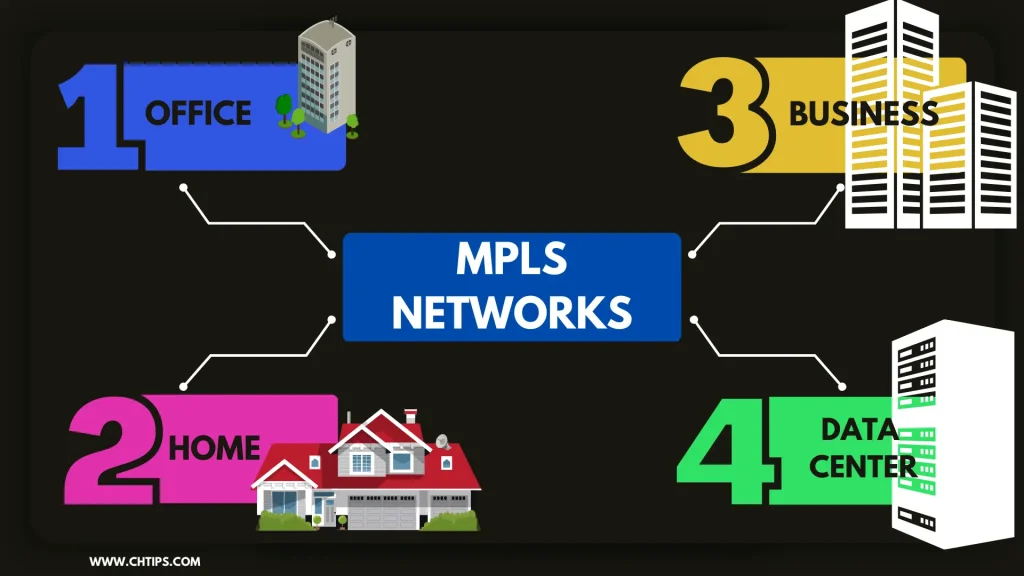
MPLS is a technique and method that is used by the majority of telecom companies. The MPLS can use data and voice calls in WAN [Wide Area Network].
MPLS was designed by engineers who developed IP [Internet Protocol] and worked on the same technology as TCP/ IP [Transmission Control Protocol / Internet Protocol].
MultiProtocol Label Switching (MPLS) is a technique used to improve your network’s performance, speed, and reliability.
MultiProtocol Label Switching (MPLS) is a technique for increasing the efficiency of packet routing in network operations.
Examples of MPLS
MPLS works with remarkable speed, accuracy, and efficiency.
Some applications need real-time data and information sharing to give users more acceptable and accurate results.
- Voice Calls.
- Video Calls.
What are the Three Types of MPLS?
There are three primary types of MPLS VPNs.
- Layer 2 VPNs.
- Layer 2 Circuits.
- Layer 3 VPNs.
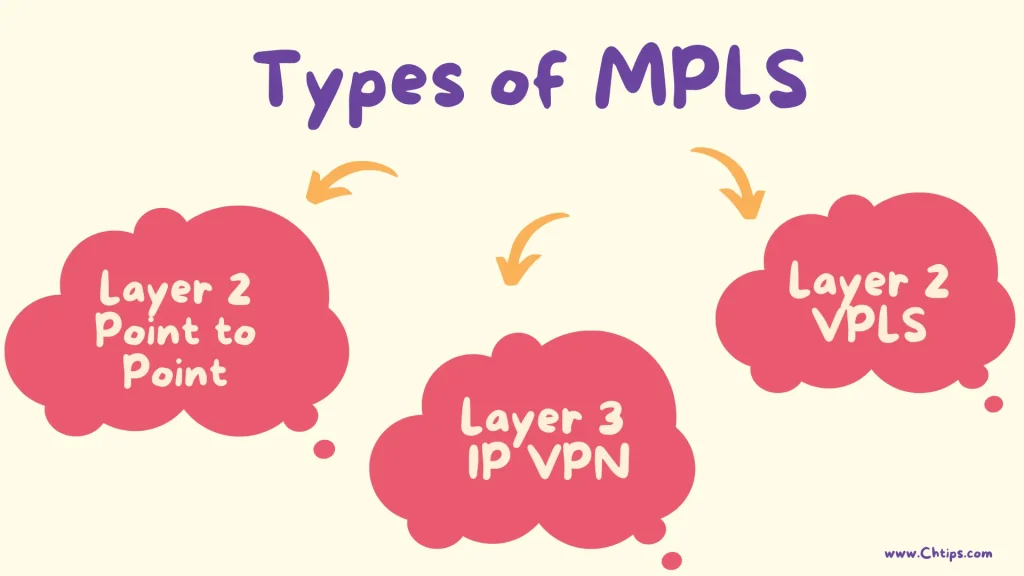
MPLS Alternatives
While MPLS (Multiprotocol Label Switching) is an extensively used networking technology, here are a few notable alternatives to MPLS.
- Software-defined WAN (SD-WAN).
- IPsec VPN.
- Direct Internet Access (DIA).
- Carrier Ethernet Services.
- Hybrid Networks.
What is VPLS in Networking
VPLS stands for Virtual Private LAN Services.
This VPLS technology enables a Local Area Network [LAN] to reach over a Wide Area Network [WAN].
VPLS is a multipoint service that can also transfer non-IP Traffic.
VPLS is a layer two multipoint VPN that connects multi-sites to the single bridged domain.
All customer sites in VPLS appear to be in the same local area network regardless of actual location VPLS uses an Ethernet interface with the customer. This applies to the LAN and WAN boundaries.
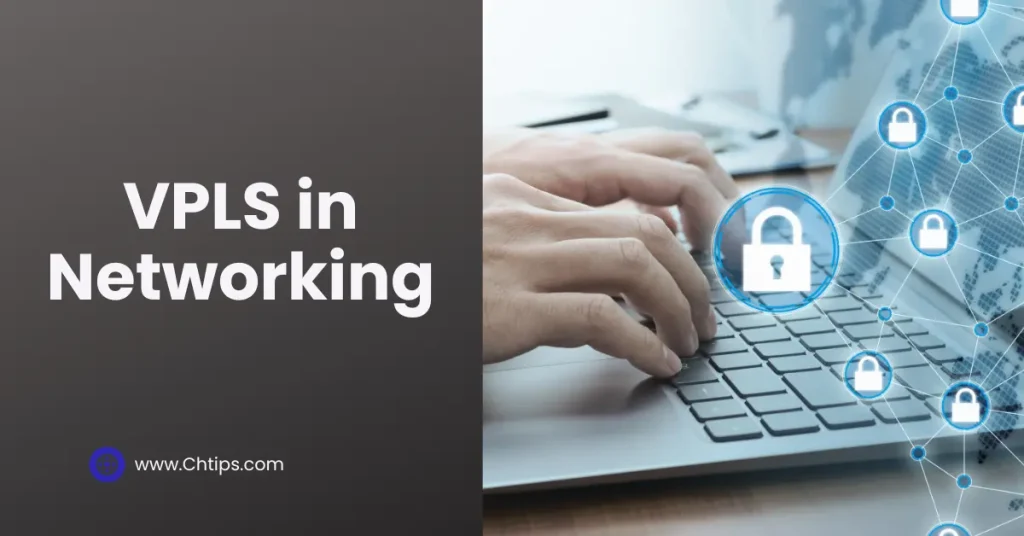
VPLS is capable of networking three main components.
- Customer Edges [CE].
- Provider Edge [PE].
- MPLS Network.
VPLS allows geographically dispersed sites to appear as part and system of the same LAN Network.
The VPLS is implemented in service provider networks to provide customers with a layer 2, ethernet-based service.
In VPLS, each site in the network is assigned a unique Virtual Circuit Identifier [VCI] that differentiates and sperate each site from others, avoiding more vulnerability.
The VPLS provider ensures that frames transmitted between sites are delivered to the appropriate destinations using labels and maintaining a forwarding table.
VPLS can provide a transparent and scalable solution for connecting multiple sites.
Some of the significant features of VPLS are mentioned below.
- Scalability.
- Connectivity.
- Traffic Isolation.
- Broadcast and Multicast Support.
- Quality of Service (QoS).
- Easy Migrations.
- Server Provider Independence.
Examples of VPLS
Here are a few examples of how VPLS can be used for different purposes.
- Enterprise Branch Offices.
- Retail Chains.
- Educational Institutions.
- Healthcare Organizations.
- Media and Broadcasting.
- Financial Institutions.
Types of VPLS
- 4.1 Hierarchical VPLS.
- 4.2 MAC Addresses.
- 4.3 PE Auto-Discovery.
- 4.3.3 RADIUS.
- Border Gateway Protocol (BGP).
- Label Distribution Protocol (LDP).
8 Uses of VPLS
Various significant uses of Virtual Private LAN Services (VPLS) are mentioned below.
- Multi-Site Connectivity.
- Data Center Interconnectivity.
- Cloud Connectivity.
- Distributed Applications.
- Collaborative Environments.
- Service Provider Networks.
- Vertical Industries.
- Broadcast and Multicast Applications
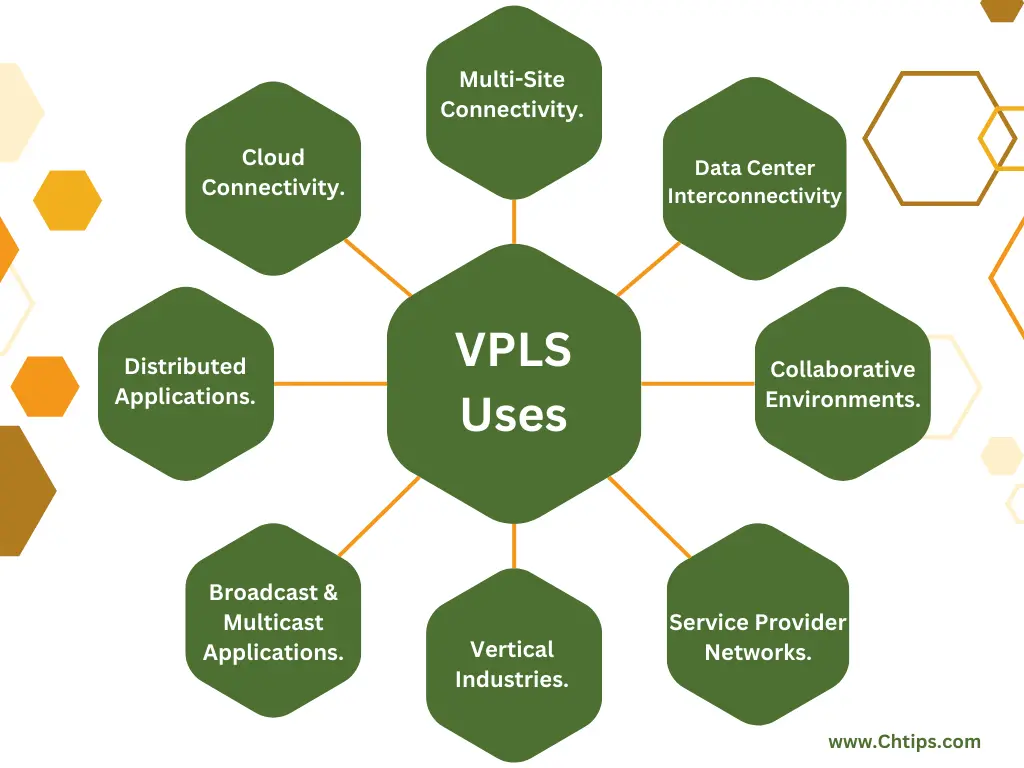
1. Multi-Site Connectivity.
VPLS is extensively used and utilized by businesses | and organizations with multiple branches and offices around the geographical area connected through LANs.
VPLS enables these sites to appear as if they are on the same local network that performs smooth communications with data and information exchange.
2. Data Center Interconnectivity.
VPLS is capable of establishing and connecting data centres within a LAN network.
This enables efficient data replication, backup, and disaster recovery across multiple data centres.
3. Cloud Connectivity.
VPLS can secure high-performance connections between an organization’s on-premises infrastructure and cloud service providers.
It allows for seamless integration and extension of the LAN into the cloud, enabling organizations to leverage cloud resources as an extension of their local network.
4. Distributed Applications.
VPLS benefits organizations running distributed applications that require low-latency and high-bandwidth connectivity.
By extending the LAN across multiple sites, VPLS ensures that these applications can communicate and function as if they are on the same local network, regardless of their physical location.
5. Collaborative Environments.
VPLS facilitates collaboration among geographically dispersed teams by providing a unified LAN experience.
It allows for seamless file sharing, real-time communication, and other collaborative applications, enhancing productivity and teamwork.
6. Service Provider Networks.
VPLS is a common offering by service providers as a Layer 2 Ethernet service.
It enables service providers to deliver scalable and secure connectivity solutions to their customers, catering to their LAN extension needs.
7. Vertical Industries.
VPLS finds applications in various vertical industries.
For example, VPLS can connect multiple trading floors or branch offices in the financial sector to enable real-time data exchange.
VPLS can facilitate secure and seamless communication between hospitals, clinics, and other healthcare facilities.
8. Broadcast and Multicast Applications.
VPLS supports broadcast and multicast traffic, making it suitable for applications that rely on these features, such as video streaming, IPTV, or IP-based surveillance systems.
VPLS ensures that broadcast and multicast traffic is efficiently delivered across the LAN extension.
VPLS provides a flexible and scalable solution for connecting multiple sites and extending LANs over wide-area networks.
Full Form of MPLS
Multiprotocol Label Switching
Full Form of VPLS
Virtual Private LAN Service (VPLS)
Difference Between MPLS and VPLS [MPLS Vs VPLS] Comparison Table
MPLS (Multiprotocol Label Switching) and VPLS (Virtual Private LAN Service) are networking technologies that connect geographic sites to access data and information more efficiently.
Here are some additional details on the differences between MPLS and VPLS.
| # | MPLS | VPLS |
| 1 | MPLS Stands for Multiprotocol Label Switching. | VPLS stands for Virtual Private LAN Services. |
| 2 | MPLS is a Label Stacking. | VPLS is an Ethernet Provider. |
| 3 | MPLS operates at the network layer [Layer 3]. | VPLS operates at the data link layer (Layer 2). |
| 4 | MPLS is designed to route IP packets efficiently across a network. | VPLS focuses on extending Ethernet-based LANs. |
| 5 | MPLS uses routing protocols to make forwarding decisions based on IP addresses. It assigns labels to packets and uses these labels to route Traffic across the network. | VPLS uses bridging techniques to create a virtual bridge between LANs, treating them as part of the same LAN segment. |
| 6 | MPLS is typically used in wide area networks (WANs) to establish efficient and reliable connections between different sites. | VPLS is a specific application of MPLS that is used to extend LANs over a WAN |
| 7 | MPLS is connection-oriented and uses labels to direct Traffic along predetermined paths through the network. | VPLS is connectionless and allows for any-to-any connectivity between different LANs. |
| 8 | MPLS is highly scalable and can handle large networks with thousands of endpoints and nodes. It can efficiently route Traffic based on IP addresses and dynamically adjust to changes in network topology. | VPLS is used in smaller-scale deployments since it focuses on extending LANs rather than routing IP traffic. |
| 9 | VPLS, as mentioned earlier, is often used by enterprises with multiple branches or data centers. | VPLS, as mentioned earlier, is often used by enterprises with multiple branches or data centres. |
| 10 | MPLS can be used for a wide range of networking purposes. | VPLS is a specialized solution within the MPLS framework for extending LANs. |
| 11 | VPLS, a Layer 2 technology, does not require routing protocols for forwarding decisions. | VPLS, a Layer 2 technology, does not require routing protocols for forwarding decisions. |
| 12 | MPLS has a distinct control plane that manages label distribution, sets up and tears down label-switched paths, and maintains the forwarding tables. | VPLS does not have a separate control plane. |
| 13 | MPLS networks are commonly deployed and managed by service providers as a managed service offering to customers. | VPLS, while also often offered by service providers, is a specific service within the MPLS infrastructure that provides Layer 2 connectivity. |
| 14 | MPLS networks are designed to handle large-scale deployments and can scale to support many endpoints. | VPLS networks, while scalable in their own right, are generally used in smaller-scale scenarios. |
Both MPLS and VPLS have their pros and cons. MPLS is extensively used and utilized for its routing capabilities and efficient WAN connectivity.
Whereas, VPLS, an application of MPLS, is well suited for organizations looking to extend their LANs across geographical areas and to support diverse types of Traffic.
Recommended Reading
- Applications of Star Topology
- Top 11+ Advantages and Disadvantages of MPLS
- Basic Block Diagram of Optical Communication System
- Advantages and Disadvantages of Star Topology
- 15+ Advantages and Disadvantages of Mesh Topology
- What is a Port in Networking? Its Types, Functions with Examples
- Characteristics of Star Topology Networking in Computer
- Applications of Ring Topology in Computer Network
- Functions of Bridge in Networking
- Features of Star Topology in Computer Networks
- 10 Applications of Star Topology in Real Life
- Characteristics of MAN in Computer Network
- What is a Port in Networking
- Advantages and Disadvantages of LAN {Local Area Network}
- Advantages and Disadvantages of WAN
- Computer Basic Tutorials
Difference Between MPLS and VPLS [MPLS Vs VPLS] Using Image
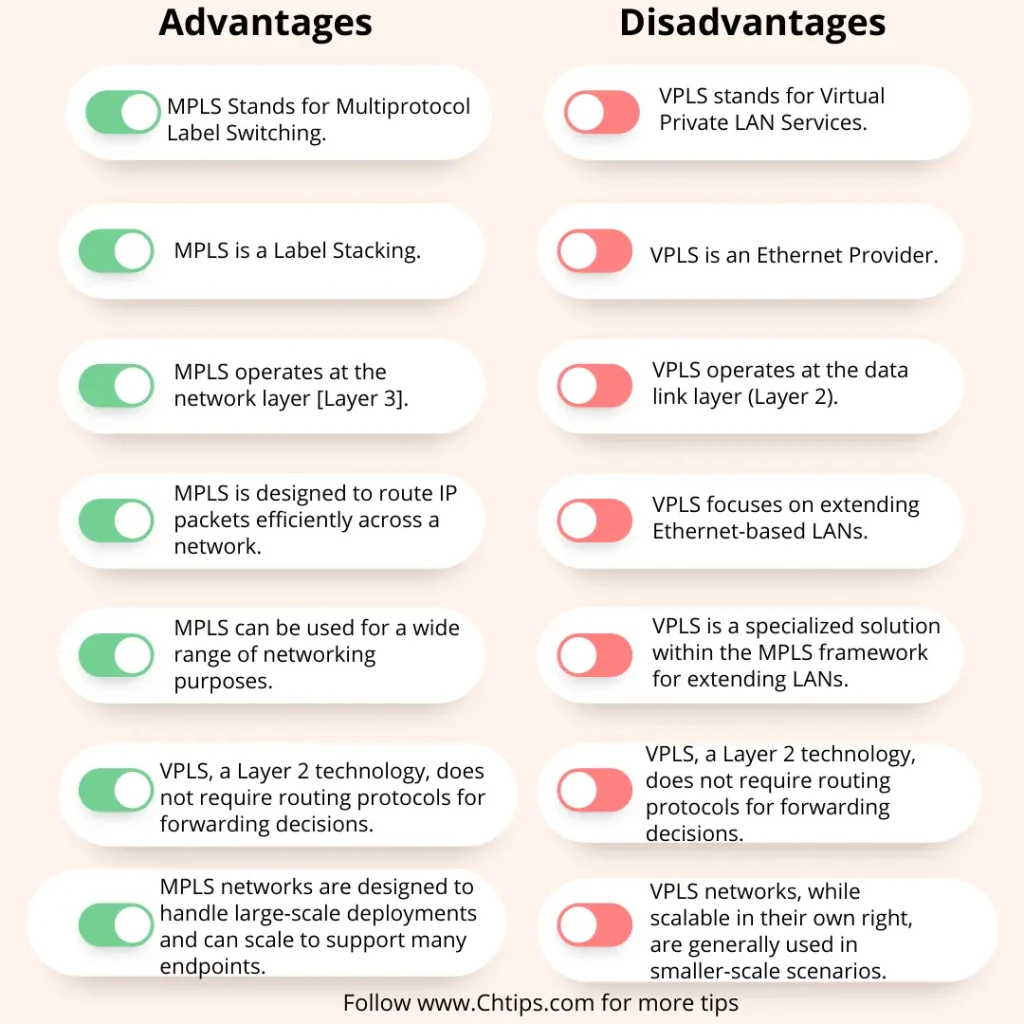
Difference Between MPLS and VPLS [VPLS Vs MPLS] PDF Download
Useful Video: On MPLS VS VPLS [YT]
5+ Advantages and Disadvantages of MPLS in Comparison Table
| # | Advantages | Disadvantages |
| 1 | It helps and assists Voice Over Internet Protocol. | Security is an issue with MPLS, as controls are in the hands of users. |
| 2 | Improved speed and performance. | Maintenance can be a point to look after periodically. |
| 3 | They are inexpensive in setup. | Installation, Deployment, and Setup can be an issue with MPLS. |
| 4 | They can be scaled up. | MPLS is not optimized and configured with cloud applications and programs. |
| 5 | Uptime increase can be observed. | It needs WAN [Wide Area Network] configuration and optimization. |
5+ Advantages and Disadvantages of VPLS
Advantages of VPLS
- Seamless LAN Extensions are used in VPLS.
- VPLS provides any-to-any connectivity between different LANs within the VPLS network.
- VPLS is flexible, allowing direct site communication and facilitating efficient collaboration and resource sharing.
- The Traffic from different LANs is isolated from each other. They also provide secure and private communication.
- VPLS networks are highly scalable, allowing them to expand and easily add new sites to their network.
Disadvantages of VPLS
- VPLS can be more expensive compared to other networking solutions.
- VPLS needs dedicated hardware, network equipment, and skilled personnel to maintain the network.
- VPLS performance and available bandwidth depend on the service provider’s capabilities.
- Service issues on the provider’s side can impact the performance and availability of the VPLS network.
- Implementing and managing a VPLS network can be complex, especially for organizations with limited networking expertise.
Frequently Asked Questions [FAQs] MPLS Vs VPLS
Is VPLS Layer 2 or 3
Layer 2.
Is VPLS a Protocol
Internal Routing Protocols.
Is MPLS a LAN or a WAN
Wide Area Network (WAN).
What are the two modes of MPLS?
Downstream-on-demand (DoD) label distribution mode.
Unsolicited Downstream (UD) label distribution mode.
Is MPLS a VPN
Multiprotocol Label Switching (MPLS) to create virtual private networks (VPNs)
Where is MPLS used today
Real-time applications, voice calls and video calls.
Is MPLS a Layer 2 or 3
MPLS is considered layer 2.5
Get In Touch
I have also written and compiled some articles on computers and telecommunications, and please go through them.
I hope you will like reading it.
All the questions and queries related to the 14+ Difference Between MPLS and VPLS with examples and images have been answered here.
If you have any questions related to MPLS Vs VPLS.
Don’t hesitate to contact me, and if you need to add, remove or update anything from the article, please let me know in the comment section or via email.
I will be more than happy to update the article. I am always ready to correct myself.
Please share this article with your friends and colleagues; this motivates me to write more on related topics.
!!! Thank You !!
![14+ Difference Between MPLS and VPLS [MPLS Vs VPLS] 1 Difference Between MPLS and VPLS](https://www.chtips.com/wp-content/uploads/2023/06/Difference-Between-MPLS-and-VPLS.webp)